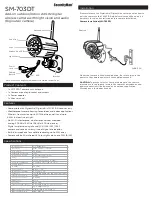
12
13
GB
1� About this document
Please read carefully and keep in a safe
place�
– Under copyright. Reproduction either in
whole or in part only with our consent.
– Subject to change in the interest of technical
progress.
Symbols
!
Hazard warning!
...
Reference to other information
in the document�
2� General safety notification
!
• This product must only be installed by a
qualified electrician in accordance with
national wiring regulations as defined in
VDE 08 29 (DIN EN 500090).
• Installed improperly, low-voltage products
can cause extremely serious personal injury
or damage to property.
• This product must never be connected to a
230 V AC power supply as it is intended for
connection to an extra-low voltage power
supply.
3� sensIQ KNX
The unit is equipped with pyro sensors that
detect the invisible heat emitted by moving
objects (people, animals etc.). The heat detect-
ed in this way is converted electronically into
a signal that switches a connected load ON
load (e.g. a light). Heat is not detected through
obstacles, such as walls or panes of glass.
Heat radiation of this type will, therefore, not
trigger the sensor.
Package contents
(Fig� 3�1)
Product dimensions
(Fig� 3�2)
Unit parts
(Fig� 3�3)
A Sensor unit
B Reach adjustment
C Status LED
D Sensor housing
E Programming button
F Wall mount
Corner wall mount
(Fig� 3�4)
4� Installation
• Switch OFF power supply
(Fig� 4�1)
.
• Wiring diagram
(Fig� 4�2)
.
5� Mounting
• Check all components for damage.
• Do not use the product if it is damaged.
• Select a mounting location suitable for ceiling
or wall mounting.
Mounting procedure
• Undo locking screw
(Fig� 5�2)
.
• Detach wall mount from lens housing.
• Drill condensation water drainage hole de-
pending on how the unit is aligned
(Fig� 5�3)
.
• Mark drill holes
(Fig� 5�4)
.
KNX power supply lead, concealed
• Drill holes and insert wall plugs
(Fig� 5�5)
.
• Make sure the connection cable is wired
up correctly
(Fig� 5�5)
.
• Connect power supply lead plug connector
(Fig� 5�5)
.
KNX power supply lead, surface-mounted
• Drill holes and insert wall plugs
(Fig� 5�6)
.
• Make sure the connection cable is wired up
correctly
(Fig� 5�6)
.
• Connect power supply lead plug connector
(Fig� 5�6)
.
• If the power supply lead is surface-mounted,
drill open cable entry on the sensor housing
and file edges to make them smooth
(Fig� 5�7)
.
• Connect sensor plug connector
(Fig� 5�8)
.
• Fit lens housing onto wall mount
(Fig� 5�9)
.
• Check position of connection cable
(Fig� 5�10)
.
• Screw in locking screw
(Fig� 5�11)
.
• Switch ON power supply
(Fig� 5�12)
.
• Make settings
➜
"6� Operation",
➜
"7� / 8� Function"
6� Operation
Note:
To calibrate the product, please go to
knx�steinel�de
1. Issue physical address and generate
calibration program in the ETS.
2. Load the physical address and calibration
program into the presence detector. When
you are prompted, press the
programming button
(E)
.
3. The red LED goes out once programming
has been successfully completed.
7� Setting functions in the unit
Factory setting
Reach = max
Mounting height
Setting
Control dial
Stan-
dard
1�8 m 2�5 m 3 m
5 m
2
2 m
2 m
3 m
4 m
4
4 m
4 m
7 m
12 m
8
8 m
7 m
12 m >20 m
12
13 m 12 m >20 m >20 m
16
19 m 16 m >20 m
–
max.
>20 m >20 m
–
–
Reach can be adjusted in 3 directions via
3 control dials (through 100° in each direction
and independently of each other). The table
shows reaches at different mounting heights
for tangential walking direction. The values
apply on flat terrain at a temperature of 20°C.
(Fig� 7�1 / Fig� 7�2)
Shroud foils
a
-
e
If the independent settings of the 3 sensors
are not sufficient, the detection zone can
restricted further by fitting shroud foils
c
,
d
,
e
(Fig� 7�3)
. Shroud foils
a
+
b
under
the sensor help to prevent the detection of
small animals. This, of course, takes these
lenses out of action and in particular results in
loss of the sneak-by guard.
Note:
The remote control does not work when
using shroud foil
b
.
Advice:
Apply a solution of water and deter-
gent to the lens before fitting the shroud foil.
This way, the foil does not adhere immediately
and gives you time to make precision adjust-
ments. The foil adheres once the detergent
solution has dried.
8� Setting functions using infrared
remote control RC 9
Remote control RC 9
Any number of sensIQ KNX can be controlled
via the RC 9 remote control. The status LED on
the sensor flashes (once) to indicate each valid
press of the button. The status LED flashes
(twice) to indicate each invalid press of the
button.
(Fig� 7�4)
The following special functions are indicated
as follows:
Permanently ON: LED permanently ON
Permanently OFF: LED permanently ON
Functions:
1
Light-level setting
The chosen response threshold can
be set from approx. 2-1000 lux.
2
Daylight operation
3
Night-time operation
4
Light-level setting via the memory
button / teach mode.
This button must be pressed at the
level of light at which you want the
sensor to respond to movement from
now on. The current value is stored.
5
Time setting
The period of time you want the light
to stay ON for after the last detected
movement can be set to 10 s, 1 min,
5 min, 15 min by pressing these
buttons.
GB































